Figures & data
Table 1. Five multi-scale approaches for calculating terrain attributes (Dolan and Lucieer Citation2014). Asterisks denote marine examples.
Figure 1. Locations of study sites at (A) D’Argent Bay, Newfoundland and Labrador, Canada, and (B) the Bjørnøya slide and surrounding area on the Norwegian continental margin. Source: Author, country borders were obtained from the ESRI Countries WGS84 layer.
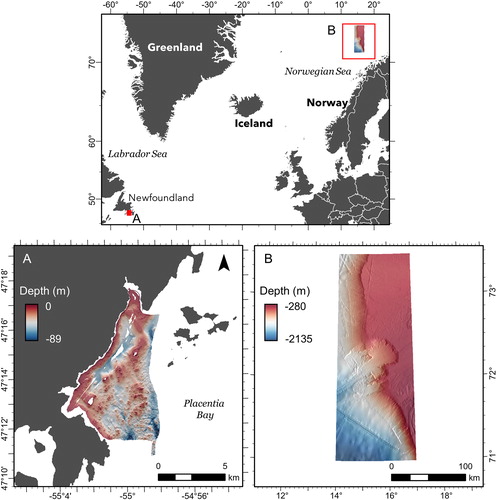
Figure 2. Calculating raster terrain attributes at analysis distance Dt = 45 m using four different multi-scale methods: (A) ‘resample-calculate’, (B) ‘average-calculate’, (C) ‘calculate-average’, and (D) ‘k × k-window’. Parameters at the bottom of each pane describe the aggregation window size (j), focal window size (k), cell length (lc), cell neighborhood size (mc), and attribute calculation distance (Di). Solid borders represent the focal cell; bold borders represent Di. Note that for (B) and (C), the analysis distance (Dt) of calculations at the focal cell is extended to 45 m by the aggregation windows of each neighboring cell within the 3 × 3 focal window.
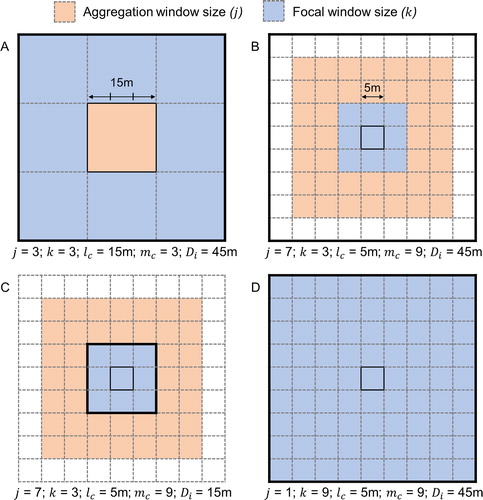
Table 2. Example of scale manipulation parameters over ten analysis distances (Dt) based on multi-scale calculation method, applied to a 5 m resolution input dataset. An example with a 250 m resolution input dataset is provided in the Appendix. Note how Di and Dt vary relative to the other parameters and each other.
Figure 3. Hillshaded 5 m resolution bathymetry at D’Argent Bay. A terrain profile from West to East (A) shows topographic features at several scales. Finer-scale features are superimposed on broader ones (B).
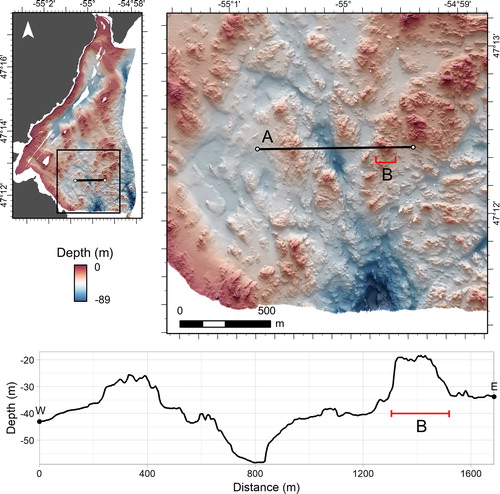
Figure 4. Relative difference to the mean value (RDMV) at the transect in across ten analysis distances (Dt) using four different multi-scale calculation methods at D’Argent Bay. Values at the finest scale (red) describe correspondingly small topographic features; values at moderate (green) and broad (purple) scales differ substantially between methods. Dashed lines indicate the extent of the feature indicated in .

Figure 5. Slope at the transect in calculated across ten analysis distances (Dt) using four different multi-scale calculation methods at D’Argent Bay. Slope details and flat areas are averaged out using the ‘calculate-average’ method. Dashed lines indicate the extent of the feature indicated in .
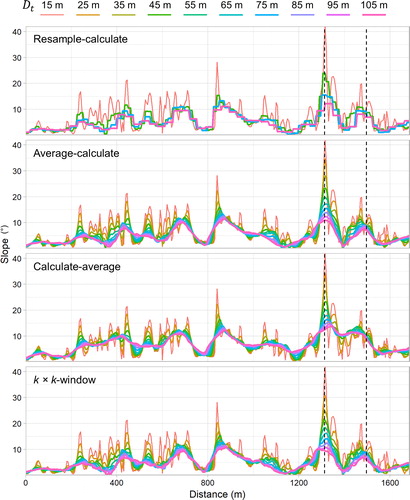
Figure 6. Hillshaded slope at D’Argent Bay. The magnified area shows features along the terrain profile. At analysis distance Dt = 15 m (A), an arrow indicates the feature discussed in the text and annotated in . The scale of the slope layers is increased to Dt = 65 m using (B) ‘calculate-average’ and (C) ‘k × k-window’ methods. The color ramp is clipped to a maximum of 20° to facilitate comparison between maps.
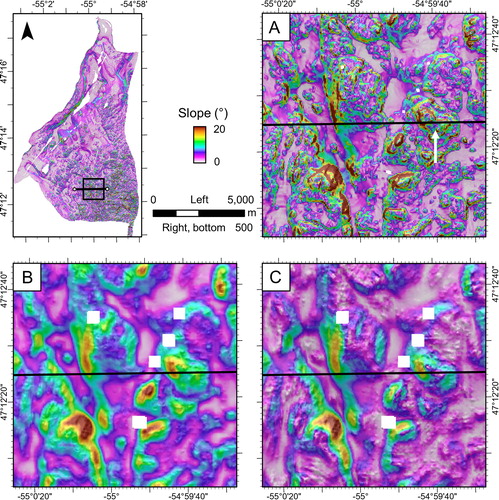
Figure 7. Average correlation and entropy statistics of terrain attributes compared to the finest scale using each multi-scale calculation method at D’Argent Bay. Error bars show the standard deviations of all variables at each analysis distance.
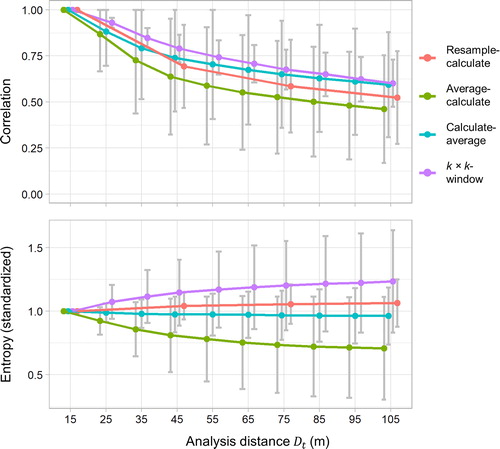
Figure 8. Hillshaded 250 m resolution GEBCO bathymetry (left) and data source identified via type identifier (TID) grid (right) at the Bjørnøya slide. A terrain profile from North to South (A; bottom) crosses what appears to be a dataset compilation boundary (at B) near the crown of the slide. Note that the pre-generated grid sections contain multiple data sources and are not necessarily of uniform quality/resolution. The pre-generated grid data south of B comprise full-coverage multibeam bathymetry from which more consistent terrain attributes are expected.
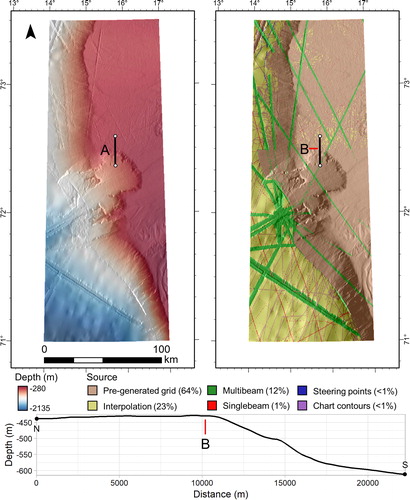
Figure 9. Effects of terrain attribute calculation methods on multisource data compilation (A) artefacts at the Bjørnøya slide. Relative difference to the mean value (RDMV) and eastness at analysis distance Dt = 750 m (B, G) are increased to Dt = 3,750 using ‘resample-calculate’ (C, H), ‘average-calculate’ (D, I), ‘calculate-average’ (E, J), and ‘k × k-window’ (F, K) methods. The data compilation boundary identified in is indicated by the dashed red line in (A).
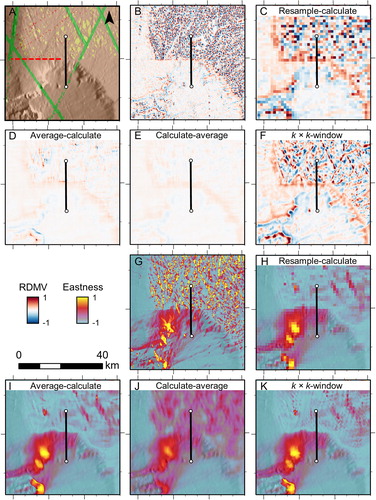
Figure 10. Eastness from North to South (left to right) at the profile in and calculated across ten analysis distances (Dt) using four different multi-scale calculation methods at the Bjørnøya slide. Vertical dashed lines show approximate locations of the slide crown (black) and dataset compilation boundary (red).
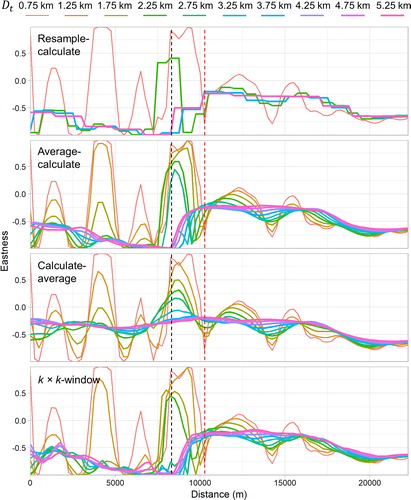
Figure 11. Scaled (0-1) absolute error between all terrain attribute values at ‘actual’ and ‘measured’ sample sites for multiple analysis distances at D’Argent Bay. Box plots show the error distributions at analysis distances that can be achieved using all multi-scale calculation methods (i.e., including ‘resample-calculate’), with means at all scales displayed as circles.
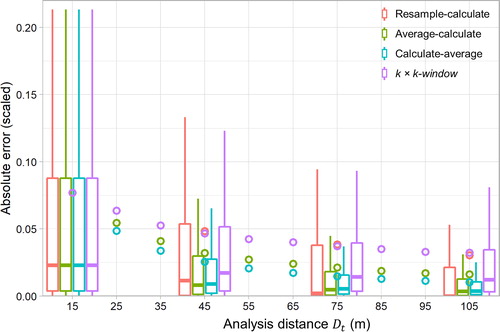
Table 3. Comparison of relative suitability of multi-scale calculation methods for the three purposes identified in this study.
Table A1. Example of scale manipulation parameters over ten analysis distances (Dt) based on multi-scale calculation method, applied to a 250 m resolution input dataset.
Figure A1. Average correlation and entropy statistics of terrain attributes compared to the finest scale using each multi-scale calculation method at the Bjørnøya slide. Standard deviations are shown by the error bars.
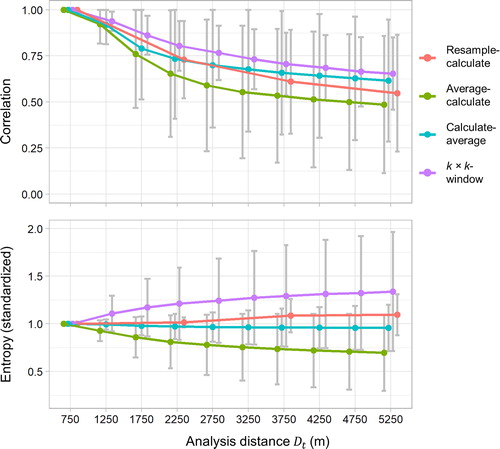
Figure A2. Eastness at D’Argent Bay at analysis distance Dt = 15 m (A) is increased to Dt = 65 m using (B) ‘resample-calculate’, (C) ‘average-calculate’, (D) ‘calculate-average’, and (E) ‘k × k-window’ methods.
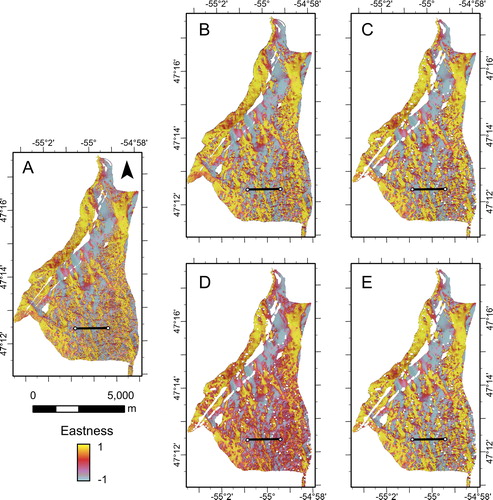
Figure A3. Relative difference to the mean value (RDMV) at D’Argent Bay at analysis distance Dt = 15 m (A) is increased to Dt = 65 m using (B) ‘resample-calculate’, (C) ‘average-calculate’, (D) ‘calculate-average’, and (E) ‘k × k-window’ methods.
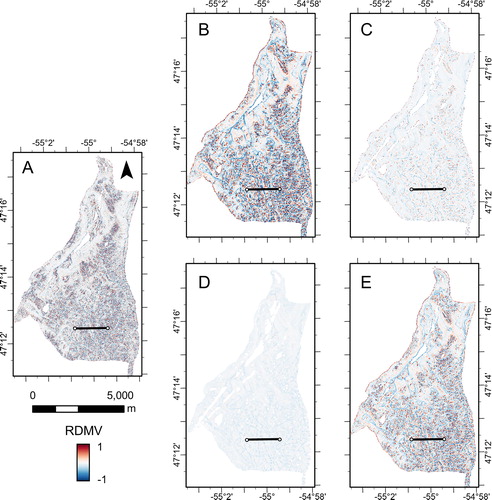
Figure A4. Bathymetric standard deviation at D’Argent Bay at analysis distance Dt = 15 m (A) is increased to Dt = 65 m using (B) ‘resample-calculate’, (C) ‘average-calculate’, (D) ‘calculate-average’, and (E) ‘k × k-window’ methods.

Figure A5. Slope at D’Argent Bay at analysis distance Dt = 15 m (A) is increased to Dt = 65 m using (B) ‘resample-calculate’, (C) ‘average-calculate’, (D) ‘calculate-average’, and (E) ‘k × k-window’ methods.
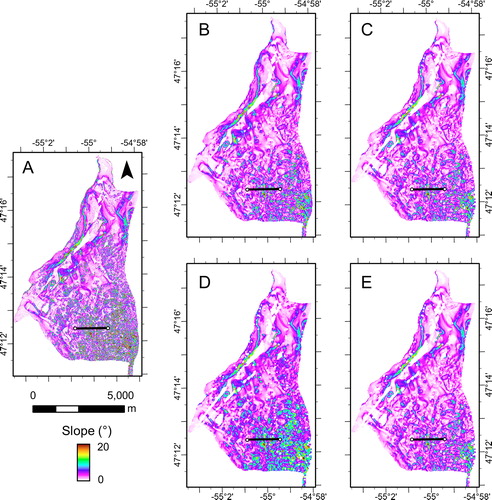
Figure A6. Vector ruggedness measure (VRM) at D’Argent Bay at analysis distance Dt = 15 m (A) is increased to Dt = 65 m using (B) ‘resample-calculate’, (C) ‘average-calculate’, (D) ‘calculate-average’, and (E) ‘k × k-window’ methods.
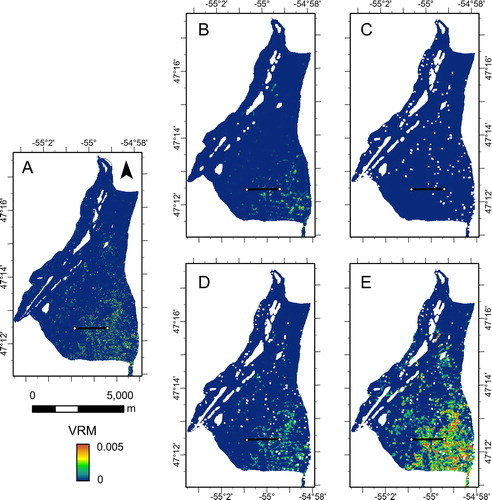
Figure A7. Eastness at the transect in calculated across 10 analysis distances (Dt) using four different multi-scale methods at D’Argent Bay.
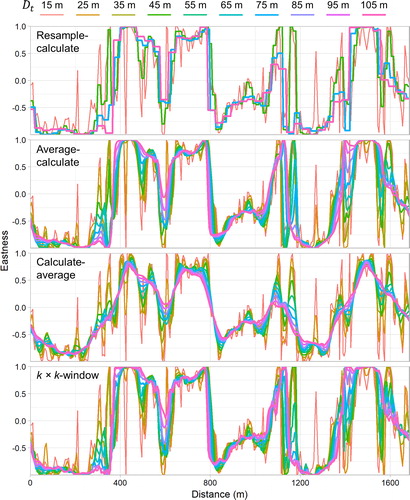
Figure A8. Bathymetric standard deviation at the transect in calculated across 10 analysis distances (Dt) using four different multi-scale methods at D’Argent Bay.
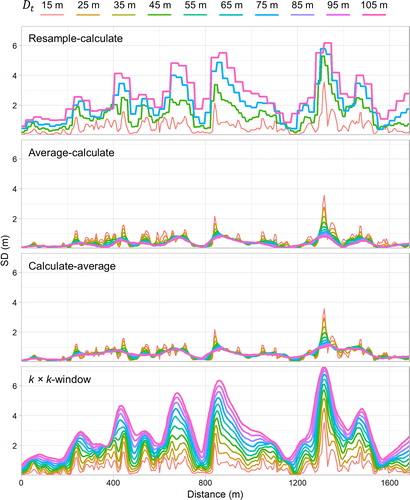
Figure A9. Vector ruggedness measure (VRM) at the transect in calculated across 10 analysis distances (Dt) using four different multi-scale methods at D’Argent Bay.
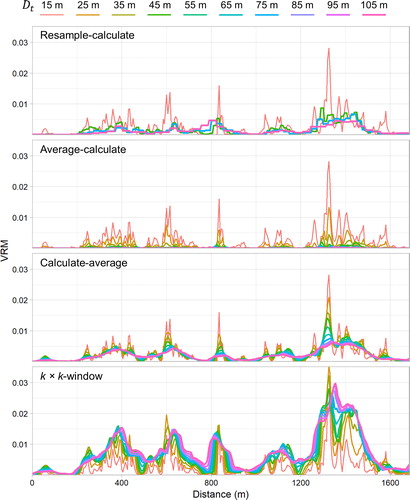
Figure A10. Eastness at the Bjørnøya slide at analysis distance Dt = 750 m (A) is increased to Dt = 3,750 m using (B) ‘resample-calculate’, (C) ‘average-calculate’, (D) ‘calculate-average’, and (E) ‘k × k-window’ methods.
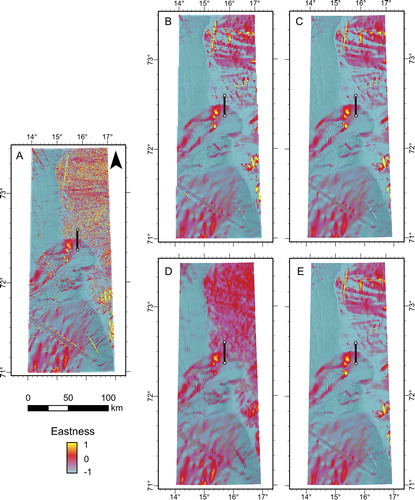
Figure A11. Relative difference to the mean value (RDMV) at the Bjørnøya slide at analysis distance Dt = 750 m (A) is increased to Dt = 3,750 m using (B) ‘resample-calculate’, (C) ‘average-calculate’, (D) ‘calculate-average’, and (E) ‘k × k-window’ methods.
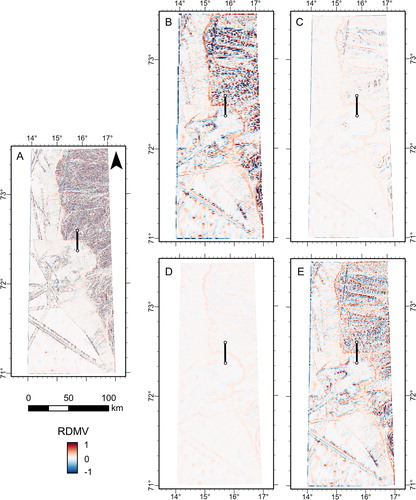
Figure A12. Bathymetric standard deviation at the Bjørnøya slide at analysis distance Dt = 750 m (A) is increased to Dt = 3,750 m using (B) ‘resample-calculate’, (C) ‘average-calculate’, (D) ‘calculate-average’, and (E) ‘k × k-window’ methods.
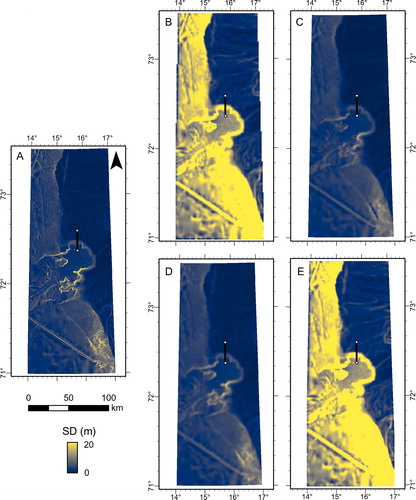
Figure A13. Slope at the Bjørnøya slide at analysis distance Dt = 750 m (A) is increased to Dt = 3,750 m using (B) ‘resample-calculate’, (C) ‘average-calculate’, (D) ‘calculate-average’, and (E) ‘k × k-window’ methods.
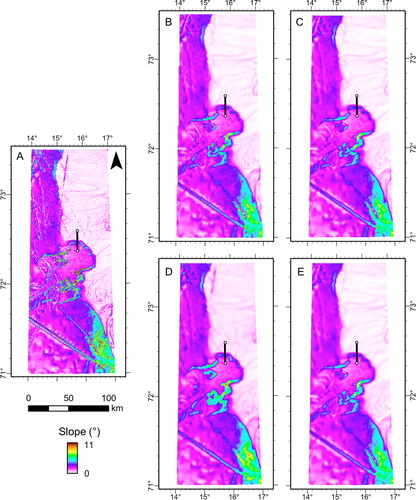
Figure A14. Vector ruggedness measure (VRM) at the Bjørnøya slide at analysis distance Dt = 750 m (A) is increased to Dt = 3,750 m using (B) ‘resample-calculate’, (C) ‘average-calculate’, (D) ‘calculate-average’, and (E) ‘k × k-window’ methods.
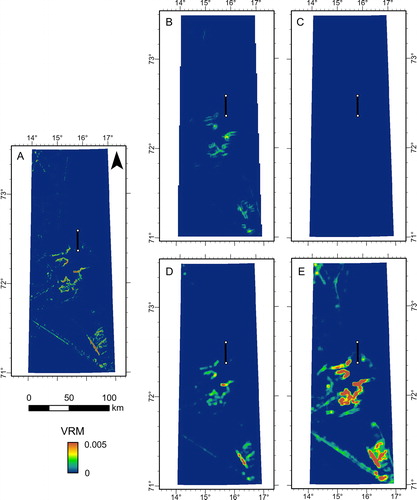
Figure A15. Relative difference to the mean value (RDMV) from North to South (left to right) at the profile in calculated across 10 analysis distances (Dt) using four different multi-scale methods at the Bjørnøya slide. Vertical dashed lines show approximate locations of the slide crown (black) and dataset compilation boundary (red).

Figure A16. Bathymetric standard deviation from North to South (left to right) at the profile in calculated across 10 analysis distances (Dt) using four different multi-scale methods at the Bjørnøya slide. Vertical dashed lines show approximate locations of the slide crown (black) and dataset compilation boundary (red).
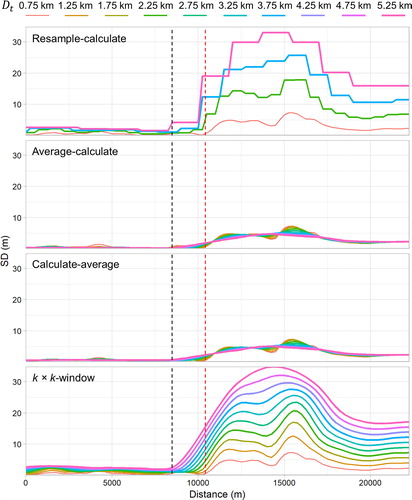
Figure A17. Slope from North to South (left to right) at the profile in calculated across 10 analysis distances (Dt) using four different multi-scale methods at the Bjørnøya slide. Vertical dashed lines show approximate locations of the slide crown (black) and dataset compilation boundary (red).

Figure A18. Vector ruggedness measure (VRM) from North to South (left to right) at the profile in calculated across 10 analysis distances (Dt) using four different multi-scale methods at the Bjørnøya slide. Vertical dashed lines show approximate locations of the slide crown (black) and dataset compilation boundary (red).
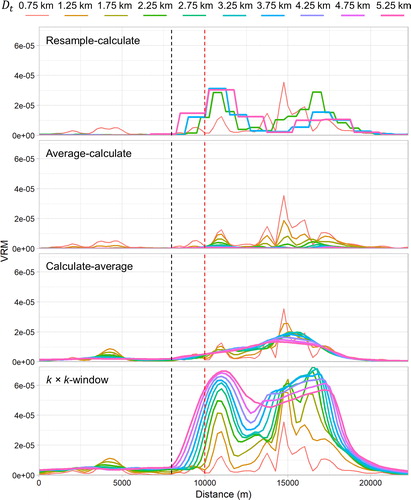
Supplemental Material
Download R Objects File (3.1 KB)Supplemental Material
Download R Objects File (3.3 KB)Supplemental Material
Download PDF (279.2 KB)Data availability statement
The GEBCO_2019 bathymetry data supporting the findings in this study are available for free from the GEBCO data portal: https://www.gebco.net/data_and_products/gridded_bathymetry_data/gebco_2019/gebco_2019_info.html. Access to the D’Argent Bay multibeam data will be considered upon request by the authors.
